Underground in Japan & Israel
Book review: « Tonoharu, Vol.2» by Lars Martinson
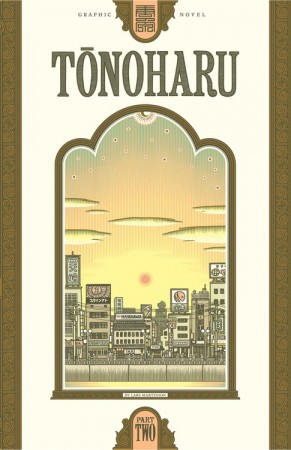
The second volume of Martinson’s look at an American English teacher adjusting to life in rural Japan, inspired by the author’s own stay in Japan as a teenager. As the months go by, Dan Wells settles into his life as an assistant junior high school teacher in the rural Japanese village of Tonoharu. According to Lars Martinson:”The first book focuses on the sense of loneliness and isolation that occurs after the “honeymoon period” of cultural acclimation ends. The second book deals with the relationships that develop, both with members of the native population and with other expats.” (Justin Tedaldi: Interview with ‘Tonoharu’ cartoonist Lars Martinson).
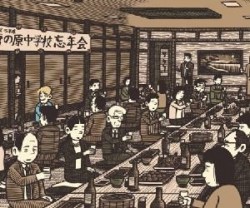 I’ve read both volumes (review of the first volume here: Tonoharu Vol.1), but I have the feeling that Dan is still isolated by language and cultural barriers from those around him. He may lead a less solitary existence, but I never have the impression that he connects with anybody. Now, he’s not lost in translation but his sexual liaison with a Japanese teacher hardly qualifies as a meaningful relationship. Actually, their meetings leave an impression of emptiness and through his contained style, the stylized drawing and the muted colors, Martinson shows that his character remains in his bubble and doesn’t really understand the Japanese or expat world around him. In the picture on the left, you can see that Dan is the only character in color, thus isolating him visually from the Japanese guests of the restaurant. Again in the scene of the train station below, he is sitting alone on a bench.
I’ve read both volumes (review of the first volume here: Tonoharu Vol.1), but I have the feeling that Dan is still isolated by language and cultural barriers from those around him. He may lead a less solitary existence, but I never have the impression that he connects with anybody. Now, he’s not lost in translation but his sexual liaison with a Japanese teacher hardly qualifies as a meaningful relationship. Actually, their meetings leave an impression of emptiness and through his contained style, the stylized drawing and the muted colors, Martinson shows that his character remains in his bubble and doesn’t really understand the Japanese or expat world around him. In the picture on the left, you can see that Dan is the only character in color, thus isolating him visually from the Japanese guests of the restaurant. Again in the scene of the train station below, he is sitting alone on a bench.
It is true that expats have difficulty building relationships in Japan. Many Japanese people think that their culture is impossible to grasp by a foreigner and they are rather puzzled by those who try. Let’s call it an extreme form of caution to prevent future embarrassment. It also seems that Dan is a loner, whether he’s happy about it or not.
Another question by Justin Tedaldi in his “Interview with ‘Tonoharu’ cartoonist Lars Martinson” deals with mangas: “Has drawing in such a stylized “Western” way versus manga style made it a much bigger time commitment to bring to completion?” I love Lars Martinson’s answer: “I don’t think I would have gone for a manga style, though, just something with less crosshatching.” Why manga? It’s a funny thing, but as soon as you say Japan, most people think “manga!” and I mean the drawing style, not the basic meaning of the word (= “comic book”). How is a country supposed to express itseld in only one style? It’s just as strange to approach US comics expecting every author to draw in the Marvel-DC superhero style. Come on! Here are a few examples of independent Japanese comic art: Shigehiro Okada’s work (his blog), Shigeyuki Fukumitsu’s work or have a look at AX, a Japanese magazine for alternative comics (Top Shelf has just published a 400-page collection of stories from ten years of AX history, edited by Sean Michael Wilson with stories compiled by Mitsuhiro Asakawa, featuring work by 33 artists, including Yoshihiro Tatsumi, Akino Kondoh, Kazuichi Hanawa, Shinichi Abe and many more.) And even if mangas were the only comic art form in Japan, does this mean that any foreign author telling a story about Japan should adopt it? But the journalist’s question doesn’t come from nowhere, mind you. As a matter of fact, it has become very fashionable in Europe to draw mangas in general, most of the time not as the best mean to express a particular vision, but for the moment of surprise or because it is cute (“Pink Diary” etc…) The “Shakespeare manga” series is another debatable example of the use of manga but this time to offer an interpretation of a more complex source. I’ll let you appreciate the result (there are different authors).
Enough said about the manga debate, I’m looking forward to volume 3 of “Tonoharu” to read how Dan evolves in the Japanese society and to enjoy more of Lars Martinson’s beautiful and effective graphic style.
.
°
Book review: « Jamilti» by Rutu Modan
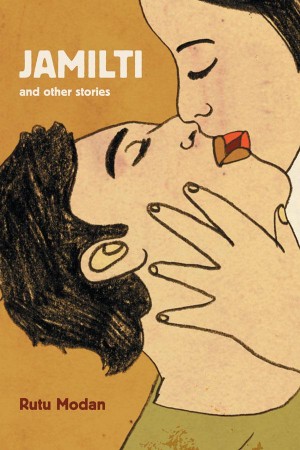
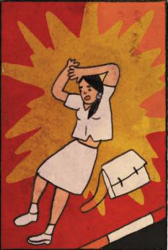
Recently, I saw the cover of “Jamilti and other stories” by Rutu Modan in a catalogue. I wasn’t familiar with this artist yet and intrigued by her graphic style, so I decided to have a look. But first of all, who is Rutu Modan? Here’s what I found:
“Born in Tel Aviv in 1966, Modan’s career has run parallel to the rise of a serious independent comics scene in Israel, which in the past fifteen years has grown large enough to provide a decent market for domestic graphic fiction. Months after first seeing Art Spiegelman’s outlandish magazine RAW as a student at the Belazel Academy of Art and Design in Jerusalem, Modan began to publish comic strips that ranged from the absurd to the macabre in local papers. “Since there was no comics tradition” in Israel at the time, she says, “I could do anything I wanted.” In 1993 she was hired to edit the Israeli edition of MAD magazine, along with artist Uri Pinkus. When it folded, Modan and Pinkus decided to start their own comics collective. “If we were going to lose money, better to do exactly what we like,” she says.” (Jascha Hoffman, “Inside Stories. Rutu Modan’s devastating, understated comics”, In Tablet Magazine, Oct 2, 2008)
In 2008, the artist got the Best New Graphic Novel Eisner award for her first graphic novel, “Exit Wounds” and “Jamilti” was published.
 “Jamilti” is a collection of short graphic novels, dealing with recurring issues, like terrorism, disguise, fairy tales, life’s regrets but also the strength to move on. Through the stories of three sisters in a themed hotel in Israel with an old family’s secret, a plastic surgeon that keeps recreating his lost love, a divorced mother who believes she can heal with electricity flowing through her hands a woman she discovers to be her ex-husband’s new wife, of suicide bombers and brides, the need and the capacity to overcome the past and live with a potentially dangerous or at least complicated present in today’s israeli society are quietly suggested.
“Jamilti” is a collection of short graphic novels, dealing with recurring issues, like terrorism, disguise, fairy tales, life’s regrets but also the strength to move on. Through the stories of three sisters in a themed hotel in Israel with an old family’s secret, a plastic surgeon that keeps recreating his lost love, a divorced mother who believes she can heal with electricity flowing through her hands a woman she discovers to be her ex-husband’s new wife, of suicide bombers and brides, the need and the capacity to overcome the past and live with a potentially dangerous or at least complicated present in today’s israeli society are quietly suggested.
Now before you think this collection is dead serious, let me tell you of the pantyhose killer. “Jamilti”‘s tone may be melancolic but it is also grotesque and the story’s final statement “That girl, I’m telling you, she never did have a sense of humor”. sounds like the ultimate criticism. This bitter-sweet mix characterizes Rutu Modan’s work and translates the lucid and ressourceful attitude of its protagonists. Once again, the disguise topic is central to the story, as a means to turn everything upside down for a moment, to forget reality for the stage of a happy show but also to express what has become a second nature in a hostile environment: the felt necessity to hide in order to escape harm and sorrow.
*
Book review: « Fuck: The Human Odyssey» by Martin Rowson
I like Martin Rowson’s refreshing view on religion and human History (and I don’t mean it in that patronizing fashion some journalists use the word “refreshing” in, to salute an artist and at the same time completely dismissing his stance as too radical). But first things first. Who is Martin Rowson? Here’s the synopsis of his work “Fuck: The Human Odyssey”, that should enlighten us: “Award-winning cartoonist Martin Rowson tells the story of Earth, from the Big Bang, the emergence of life, the death of the dinosaurs, the dawn of civilization, the invention of the wheel, the Trojan War, the Crucifixion, the Fall of Rome, the Black Death, the Reformation, the Industrial Revolution, World War One, Nazism, consumerism, the Cold War, 9/11 and beyond to the End of the World, in sixty-seven beautiful, savage, splendidly satirical images, all with only one word in the speech bubbles.”
Got it? 1) Cartoonist, 2) Award-winning, 3) Has an opinion on the world (and why shouldn’t he?).
 So I hear you ask : “My Goodness, a book on the whole world, from the Big Bang to Woolworth (you know, the store)? It will take ages to understand it!”. No, no, silly reader, Martin Rowson puts his thoughts on the vanity of human destiny (whatever “destiny” means) in one easily understandable word: “Fuck” (I’m pretty sure my blog is going to be classified by google in the adult section from now on. It’s going to make for “great” company…). And doesn’t it say it all?
So I hear you ask : “My Goodness, a book on the whole world, from the Big Bang to Woolworth (you know, the store)? It will take ages to understand it!”. No, no, silly reader, Martin Rowson puts his thoughts on the vanity of human destiny (whatever “destiny” means) in one easily understandable word: “Fuck” (I’m pretty sure my blog is going to be classified by google in the adult section from now on. It’s going to make for “great” company…). And doesn’t it say it all?
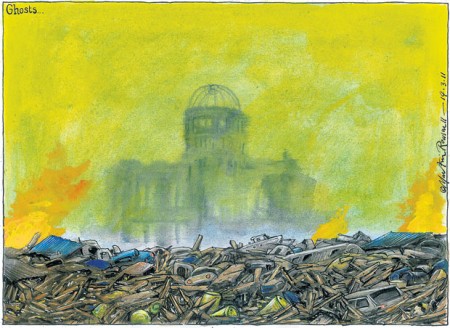 Or is there another word, commenting in more accurate terms Hiroshima, Tschernobyl, Fukushima? Didn’t think so. According to Rowson, human History is a battlefield of vanity, stupidity and sheer bad luck. And this seems to be as good as it gets, and religion is not saving anyone, just adding to the general meltdown, that has started with our creation. And in this respect, I can’t help thinking about Quark’s comment on humans shortly after arriving on Earth (for the two people who don’t know “Star Trek Deep Space Nine” and the Ferengis….Quark is a Ferengi, a greedy but smart race, not exactly burdened with morality): “They Irradiated Their Own Planet?“. Now for those of you who want it told in more words, here’s a very interesting and unusual comment by the author himself about religion, that sums up his view on a belief in a better tomorrow and in the human mind:
Or is there another word, commenting in more accurate terms Hiroshima, Tschernobyl, Fukushima? Didn’t think so. According to Rowson, human History is a battlefield of vanity, stupidity and sheer bad luck. And this seems to be as good as it gets, and religion is not saving anyone, just adding to the general meltdown, that has started with our creation. And in this respect, I can’t help thinking about Quark’s comment on humans shortly after arriving on Earth (for the two people who don’t know “Star Trek Deep Space Nine” and the Ferengis….Quark is a Ferengi, a greedy but smart race, not exactly burdened with morality): “They Irradiated Their Own Planet?“. Now for those of you who want it told in more words, here’s a very interesting and unusual comment by the author himself about religion, that sums up his view on a belief in a better tomorrow and in the human mind:
“No religion has ever had a global monopoly and despite all the attempts to ensure brand loyalty (promise of paradise, forced conversion, death for apostates, torturing and burning heretics and so on), each one has existed in a marketplace. That’s why hell is filled with demons who were once the gods of neighbouring tribes in Bronze Age Judea, placed there by the devotees of Yahweh as he muscled in on their territory to increase his market share.” (MARTIN ROWSON, “If God proved he existed, I still wouldn’t believe in him”, In: http://www.spectator.co.uk, 5th March 2008)

“But I’m not prepared to pay the price of forcing agreement on other people, beyond simply adding my voice to the beautiful Babel of human disagreement, which, like religion or keeping pets, helps define us as human.” (MARTIN ROWSON, “If God proved he existed, I still wouldn’t believe in him”, In: http://www.spectator.co.uk, 5th March 2008).
It’s harsh, but nobody ever said (other than Walt Disney maybe), that cartoons shouldn’t traumatize children and make adults improve a few things (do we need coffee for 4$ a cup? And don’t get me started on European prices of the mermaid franchises) or at least grow some lucidity when it comes to our ability to do the right things and to analyze the world. The self-righteousness that very often comes with religion (or a self-centered culture) and makes us believe nuclear energy is safe, good actions are always rewarded, poor people know the real values, children are innocent and naturally good, nature is our friend, God is white, God exists, tomorrow will be better than yesterday, smiley people are good, techno is music, reggae is music, action films are all stupid, action films are all good…is what Rowson rejects. Should we agree with him? Ah well, that’s up to us…but that cup of coffee really is expensive.
Book review: « Exit Wounds» by Rutu Modan
Exit Wounds is the tale of a female soldier (Numi) who seeks out her older boyfriend’s adult son (Koby) after her boyfriend goes missing and she fears that he’s been killed by a bomb in Hadera. As Koby and Numi work together toward unraveling the mystery of whether Koby’s father has in fact perished in the bombing, they get to know each other in a country where death has become part of daily life and where people have grown accustomed to the disappearance of a friend, a relative, a neihbor.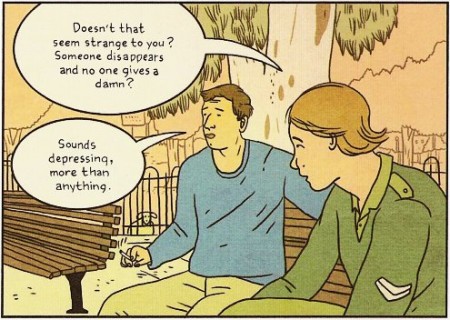
Some critics say that “Exit Wounds” concentrates on small, universal family issues, albeit sparked by the bombing of a train station and the identity of an unnamed victim. I think this analysis is somewhat misleading. Actually, the bombing and its consequences have become universal issues themselves. There’s no way to escape the constant threat as the bombings become part of the fabric of life. Their omnipresence makes us, readers, forget how exceptional the bombings should be and how this perceived normality enables the characters to go on with their lives:
“Remember that suicide bombing in Hadera three weeks ago?”
“Hadera? You mean Haifa.”
“No, not the one at the restaurant. The one in the bus station cafeteria.”
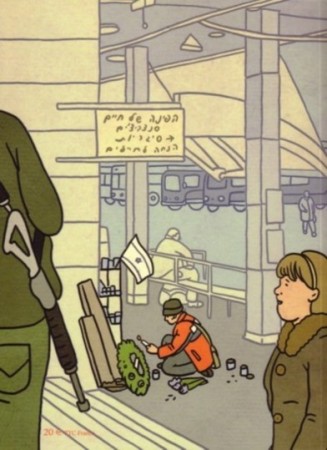 The book has received praise from comic book artist Joe Sacco, author of Palestine, who called it “a profound, richly textured, humane, and unsentimental look at societal malaise and human relationships and that uneasy place where they sometimes intersect.” (from the backcover of the album).
The book has received praise from comic book artist Joe Sacco, author of Palestine, who called it “a profound, richly textured, humane, and unsentimental look at societal malaise and human relationships and that uneasy place where they sometimes intersect.” (from the backcover of the album).
This is hardly surprising. Rutu Modan creates through her falsely naive style and the warm pastel colors a melancholic atmosphere, through which Numi and Koby are floating towards the unknown. They don’t know where the road leads to and somehow it’s not important. What’s important is to go on, but their trip makes them also realize that they need to question their past choices and find their own way. At the beginning of the graphic novel, Koby’s aunt, Ruthie, worries only about one thing: to hurry home in order to watch her favorite sitcom, “The Young and The Restless.”, a symbol of her quiet and anaesthetized existence, far away from the brutal reality of Israel. It isn’t easy for Koby to walk away from this false but soothing tranquillity but with Numi’s help and thanks to her relentless quest for the truth, he grows and starts to face the future, his future, the country’s future. While he was very passive in the beginning, Koby becomes more and more active until he ends up in a tree on his girlfriend’s property, ready to jump in the unknown, despite the barking dogs, who represent the uncertainty he will have to face, with a new confidence in his capacity to land safely.






